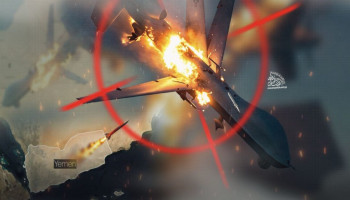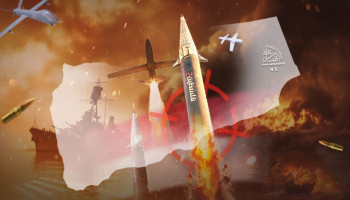As the number of enemy ships targeted by the armed forces approaches 100, as revealed by the leader of the revolution, Sayyid Abdul Malik Badr Al-Din Al-Houthi, in his last speech, the United States has unveiled a portion of the direct financial losses it has incurred during its failed attempts to counter Yemeni attacks over the past months. The US Navy Secretary acknowledged spending more than $1 billion solely on the value of defensive ammunition used in naval operations, without accounting for the costs of operating warships and aircraft carriers and the losses from rerouting ships.
The Yemeni operations, which target ships associated with “Israel”, the United States, and Britain, have been attempted to be countered by the United States over the past months through the use of high-cost defensive missiles and ammunition launched from American warships. These include SM-2 missiles, each valued at over two million dollars, and SM-6 missiles, each valued at over four million dollars.
The American Navy Secretary, Carlos Del Toro, admitted during a testimony last week before the Subcommittee on Defense Budget in the Senate, that the US Navy had exhausted defensive ammunition worth $1 billion to counter attacks by ballistic missiles and drones on American warships and commercial ships. This is a clear reference to the Yemeni operations that target ships associated with “Israel”, the United States, and Britain, which the United States has tried to counter over the past months by using high-cost defensive missiles and ammunition launched from American warships.
Del Toro stated that there is an urgent need for more than two billion dollars to renew these ammunitions and continue to provide defensive measures. The Appropriations Committee in Congress approved an annex last February that includes providing an amount of $2.4 billion under the item “Addressing the Situation in the Red Sea”, which the US Navy Secretary asked Congress to approve and pass urgently.
These amounts do not include the costs of operating warships and the Eisenhower aircraft carrier, and the aggressive air and naval raids that the United States launches on Yemen in the context of its attempts to stop the Yemeni attacks. These costs are also added to the broader economic losses as a result of rerouting ships associated with the United States towards Cape of Good Hope and preventing them from using the Red Sea, where these ships incur large additional insurance and operating costs that directly reflect on the prices of goods.
The US Navy Secretary mentioned that the American forces faced more than 130 attacks on American military and commercial ships. In contrast to these numbers and losses, the US Navy does not have any achievement. Many of its senior officers admitted in statements to various media during the past months and weeks that the United States is unable to stop the Yemeni attacks, and that the raids on Yemen did not succeed in deterring Sana’a from continuing its naval operations.
They also admitted that the situation faced by the American forces in the Red Sea and Bab al-Mandab is unprecedented and unusual, and that it represents the biggest naval challenge for America since World War II, in terms of the intensity of fire and daily attacks. As for the nature of the operations and the weapons used in them, the American officers confirmed that this is the first time in history that they face attacks by ballistic missiles on ships, and that Yemen possesses fast and deadly weapons.
Reports during the past weeks revealed that the US Navy is heading towards making immediate modifications to its systems and defensive tactics in the Red Sea, in a clear admission of the failure of the previous traditional measures. Alongside these admissions, the continuation of the Yemeni operations and their expansion to the Indian Ocean, and the continuation of hitting ships associated with the Zionist enemy, America, and Britain, despite months after the American intervention, represent a fixed fact that testifies to Washington’s failure to deal with the Yemeni front supporting Gaza.
It also confirms that the American intervention has negatively reflected on Washington itself, where its ships were not prohibited from crossing the Red Sea and the Gulf of Aden before that. Accordingly, the costs revealed by the US Navy Secretary at the level of ammunition, in fact, come within the account of losses and not defensive expenses, as there is no real defensive achievement that has been achieved through the use of this ammunition.
Yemen is approaching the targeting of the 100th ship. The American failure is also confirmed by the escalating statistics of the Yemeni naval operations, where the leader of the revolution, Sayyid Abdul Malik Badr Al-Din Al-Houthi, revealed in his speech last Thursday, that the number of ships associated with the enemy and that were targeted reached 98 ships, after carrying out 14 new operations during the past two weeks, with 36 ballistic and winged missiles and a drone, confirming that the number of targeted ships will soon reach 100.
This large number clearly proves that the United States and its allies have not even been able to form a barrier in front of the escalating pace of Yemeni naval operations, let alone stop or limit them. This means that the Yemeni armed forces have succeeded exceptionally in imposing an equation banning ships associated with the Zionist entity, the United States, and Britain, and that the renewal of American defensive ammunition will not make any difference, and will only add more financial losses to the account of American failure.
The withdrawal of three European frigates (French, Danish, and Belgian) from the Red Sea constituted an additional indication of this, where this withdrawal translated the blocked horizon in front of the military movement aimed at stopping the Yemeni operations and countering them, but it clearly expressed that this movement represents a predicament for everyone who participates in it and returns with large reverse results, and that the title “Protecting Navigation” that the United States is trying to involve other countries under its banner is nothing but a dangerous trap.
The leader of the revolution was keen in his last speech to call on European countries to withdraw their naval military pieces to avoid the American predicament, after its features became clearly visible, reiterating the confirmation that there is no threat to European ships that do not head towards the Zionist entity.







